Plenty of riders have sung the praises of the Blue Ridge Parkway. But I’m here to give you the straight story from the passenger’s point of view. You remember us; we’re the ones in the turbulence, with no handlebars to hang onto and no clear view of the road ahead.
Ours is a different experience from the front-seat rider’s, but the Blue Ridge Parkway is an amazing ride from either seat. It is the perfect marriage of non-stop curvy roads for the operator, and a 45-mph speed limit with no semi-trucks allowed for the trusting soul on the back.
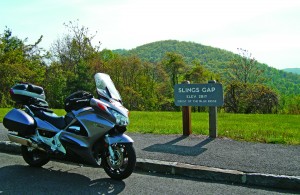
My husband, Mike, and I left Iowa City two-up on a 45-degree spring morning in early May and zipped along mostly interstates for three cold, cloudy days. By the time we reached I-64 from Charleston to Beckley, West Virginia, green, tree-smothered bluffs towered above both sides of the four lanes, followed by deep gorges. I repeatedly peeked around Mike’s helmet at his unobstructed view of the vista ahead.
On our fourth day, we joined the Blue Ridge Parkway outside Roanoke, Virginia. The National Park Service owns and maintains this roadway while preserving the area’s culture. People live along it as they always have, making it an unusual NPS experience.
This day, the air warmed. The sky cleared, brushed with wispy, white clouds. Our goal was to overnight in Boone, North Carolina, named for Daniel, who is said to have camped in that location many times.
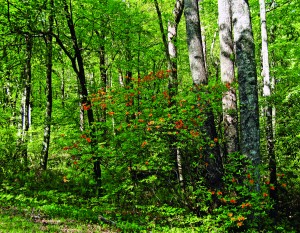
Ahead we found 170 miles of a consistently smooth road surface. No jarring bumps. No dirty air from semis. A passenger’s dream. Long, sweeping curves led us left, then right. The road climbed and fell. We met little traffic, heard only the purr of our Honda ST1300. We dismounted at numerous dramatic overlooks where uninterrupted forests rolled to the horizon.
At Mabry Mill we took a break. It has restrooms and a restaurant, both rare finds on the parkway, though there are plenty just off the route. The working gristmill is said to be the most photographed location along the way. As the waterwheel turned, two older men bagged small sacks of grits, cornmeal and flour.
We were beat when we reached Boone late in the afternoon. Signs announced it as home to Appalachian State University. It was Mother’s Day weekend, but we soon realized it was also graduation day. Would there be a room? There was…for a price.
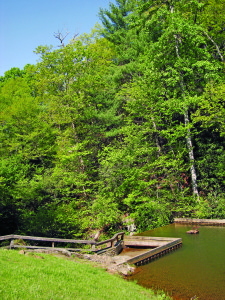
On day five, we reentered the parkway to ride 90 miles to Asheville. Getting off at Linville Falls, we hiked a half-mile to the upper falls, up and down a rocky trail. It’s a moderately difficult hike; don’t do it wearing your Gore-Tex riding pants!
Soon the parkway road became rougher and curvier, straight stretches nearly non-existent. We passed flowering dogwood and bright orange Cumberland azalea. Deer scrambled up a steep slope and an occasional lone, wild turkey strutted his stuff.
When a road sign said, “High Collision Area, Next 3 Miles,” I prepared for some “hug-your-honey-tight” moments. A series of hairpin curves followed, on a 7-percent downhill grade, good for raising this backseat rider’s heart rate.
Next we stopped at Black Mountain Overlook. The blackness is due to dark colors of red spruce and Fraser Fir blanketing the upper slopes. As was true at many overlooks, we were completely alone with nature. Absolute silence.
On through Black Mountain Gap, strong winds abruptly came out of nowhere. While Mike enjoyed protection from the windscreen, I was buffeted by gusty winds. In addition, the day’s ideal temperature took a nose dive.
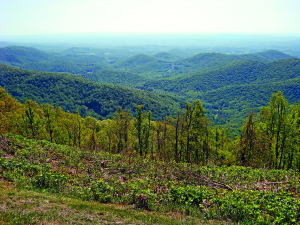
Off the bike again at Craggy Gardens, we found an expanse of naked rhododendron clinging to the steep incline. Crafted by strong winds at 5,680 feet of elevation, their twisted branches created an eerie sight.
We made our final parkway stop at Asheville’s Blue Ridge Parkway Visitors Center. A huge, modern-looking building, it features a “green” roof, sprouting a large variety of local plants. We learned that construction of the parkway began in 1935, but was not completed until 1987 when the breathtaking Linn Cove Viaduct around the edge of Grandfather Mountain was finished.
With stops, it had taken us most of the second day to reach Oteen (check out the East Village Grille for lunch) where we decided to just kick back. There are all kinds of things to do in nearby Asheville, including exploring parts of the Biltmore Estate’s 8,000 acres. But we were tired from five days of non-stop riding and still had to get back to Iowa.
There are advantages to riding the parkway in early May: light traffic and cool temperatures. The downside is that very little is in bloom. It must be a spectacular sight when the rhododendron and wildflowers explode. However, since the National Park Service describes the road as its “most heavily traveled unit,” that sight must be shared with many more vehicles, and in much greater heat.
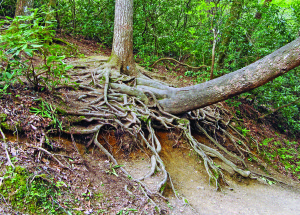
Zooming back home on interstates, we left North Carolina past wildly canted, cabin-sized boulders, the burned-rubber odor of freshly laid asphalt in the air. On days six and seven, we stuffed the bike’s luggage with our cold-weather gear as temperatures soared. Our final leg was north on U.S. 21, the Avenue of the Saints. We quit at Hannibal, Missouri, when the bike’s thermometer registered 91 degrees, a 45-degree change in one week!
The next morning, we headed home with one more ride checked off our two-up bucket list. If the Blue Ridge Parkway isn’t on your list, you need to add it. Previous accolades by other motorcyclists for the parkway are right on. This is a route both you and your backseat rider will enjoy.
Sources
blueridgeparkway.org They will mail to you, among other things, their Directory and Travel Planner, which includes information about the parkway, milepost marker by milepost marker.
nps.gov Search for Blue Ridge Parkway for maps and National Park Service information.
virtualblueridge.com Includes updated weather, road and wildflower reports. Has links for cabin rentals along the way.
byways.org Suggests possible one and two-day trips on the parkway.
(This Favorite Ride was published in the February 2013 issue of Rider magazine.)

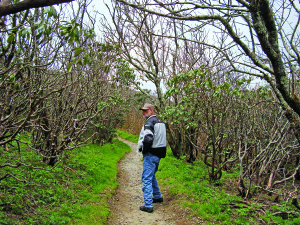
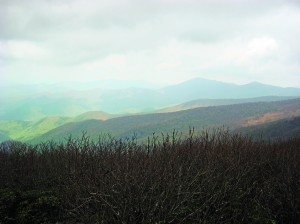
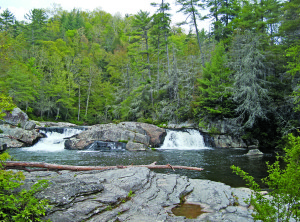
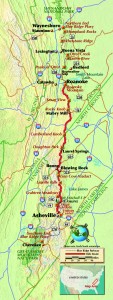







This was a part of my second multi-day long ride when I combined a run up the entire length of the Blue Ridge by continuing on up the length of the Skyline drive and then over to the Smithsonian’s extraordinary flight museum located at Dulles International Airport.
Unlike the Natchez Trace this ride will take you through several changes in not only geography but also cultures as you move from state to state. Wonderful ride that everyone who loves motorcycles and the experiences that are available to those of us who ride should put on their ‘Bucket List’.